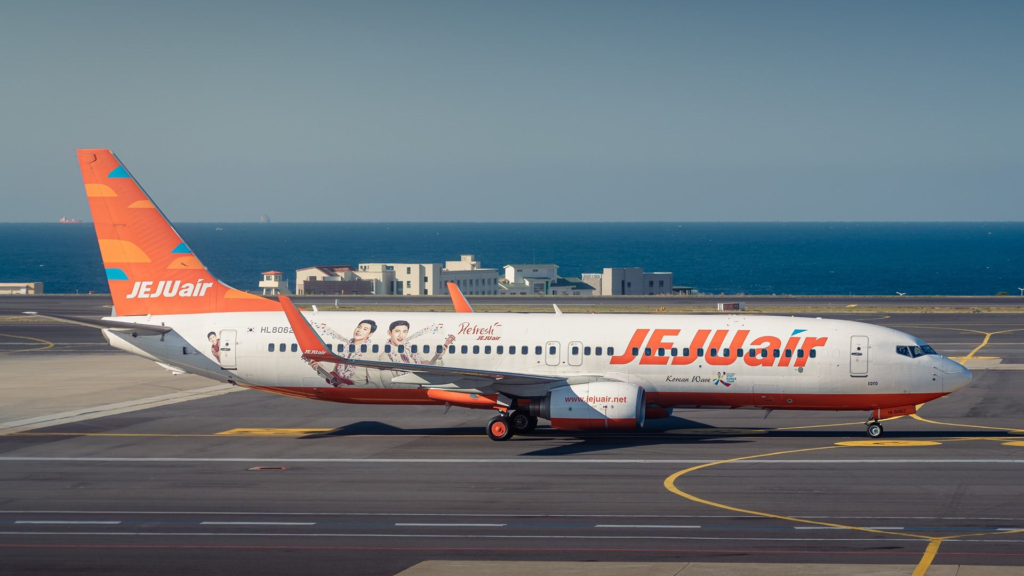Boeing is facing a lawsuit filed by families of passengers who died in the December 2024 crash of a Jeju Air Boeing 737-800. The lawsuit alleges that failures in the aircraft’s “outdated” electrical and hydraulic systems prevented the pilots from landing the plane safely. Seattle-based law firm Herrmann Law Group sued the American aircraft manufacturer on behalf of 14 families.
On December 29, 2024, the Jeju Air Boeing 737-800 made a belly landing at Muan International Airport (MWX) after failing to deploy its landing gear. The 737 overran the runway and crashed into an embankment, resulting in the deaths of 179 of the 181 people on board. The preliminary investigation report, issued in January 2025, identified the bird strike as the primary cause of the accident. South Korea’s Aviation and Railway Accident Investigation Board (ARAIB) has not yet released the final report.
Lawsuit Centers On “Outdated 737 Electrical And Hydraulic Systems”
The lawsuit, representing 14 families of passengers who died on Jeju Air flight 7C2216 from Bangkok (BKK) to Muan, argues that Boeing’s once “safety-first culture” began to erode after its 1997 merger with McDonnell Douglas. The complaint points to Harry Stonecipher, the former McDonnell Douglas CEO who later became Boeing’s president and COO, as having declared that the manufacturer would be “run like a business rather than a great engineering firm.”
The latter statement, plaintiffs said, marked a turning point away from Boeing’s traditional engineering-driven ethos. At the heart of the lawsuit is the claim that ![]() Boeing neglected to modernize the 737’s outdated electrical and hydraulic systems, whose designs date back to the aircraft’s original 1968 models, ultimately contributing to the fatal accident. Commenting on the lawsuit, Charles Herrmann, lead attorney for the plaintiff, said:
Boeing neglected to modernize the 737’s outdated electrical and hydraulic systems, whose designs date back to the aircraft’s original 1968 models, ultimately contributing to the fatal accident. Commenting on the lawsuit, Charles Herrmann, lead attorney for the plaintiff, said:
“Rather than admitting its fault in this tragic accident, Boeing resorts to its old, worn out ‘blame the pilots’ tactic. These pilots make easy targets; they perished in the flames with the passengers. They cannot defend themselves.”
Engine Vulnerability To Bird Ingestion
The preliminary crash report, released earlier this year, identified dual engine failure caused by bird ingestion. DNA recovered from both engines confirmed the presence of Baikal teal, a duck species common in East Asia, supporting the initial conclusion that bird strikes were the primary factor. The interim report issued in July 2025 stated that the crash may have resulted from the pilot mistakenly shutting down the wrong engine after a bird strike.
The Jeju Air Boeing 737, registered HL8088, experienced a bird strike while on approach to Runway 01 at Muan International Airport. Following the strike, the flight crew initiated a go-around and declared mayday. The ARAIB noted that the pilots had spotted a flock of birds during their approach. Security camera footage also showed the 737-800 passing close to the birds during the go-around.
Meanwhile, the Herrmann law firm contends that both engines were required to withstand “ingestion of up to four one-pound birds without thrust dropping below 75 percent.” Rather, they argued, the bird strike triggered a chain reaction of system failures. The lawsuit states that the DNA tests showed the birds weighed about one pound each. The statement by the law firm added that “under US Code of Federal Regulations, 14 C.F.R. §33.76(c), the aircraft’s engines were required to withstand ingestion of as many as four one-pound birds without thrust falling below 75 percent. Yet the bird strike triggered a cascade of system failures”.
Bottom Line
The lawsuit argues that both engines should have withstood the bird strike. Instead, the impact set off a chain of system failures: the landing gear failed to extend. The reverse thrusters, which help slow the aircraft, also failed, and the flaps, slats, and spoilers did not deploy. The Flight Data Recorder, Cockpit Voice Recorder, and transponder all went offline simultaneously.
The complaint also argued that these failures stem from the Boeing 737’s outdated electrical and hydraulic systems, which are based on a design dating back to 1968.
Herrmann explained: “Although these seasoned pilots managed to fly the aircraft back to the runway, the failure of all these systems combined to deny them the means to land safely. They landed 1,200 meters down the 2,600-meter runway at 175 mph — too far and too fast. Sliding on its belly, the aircraft overran the end of the runway to strike a concrete-reinforced berm built to support Instrument Landing System antennas.”





